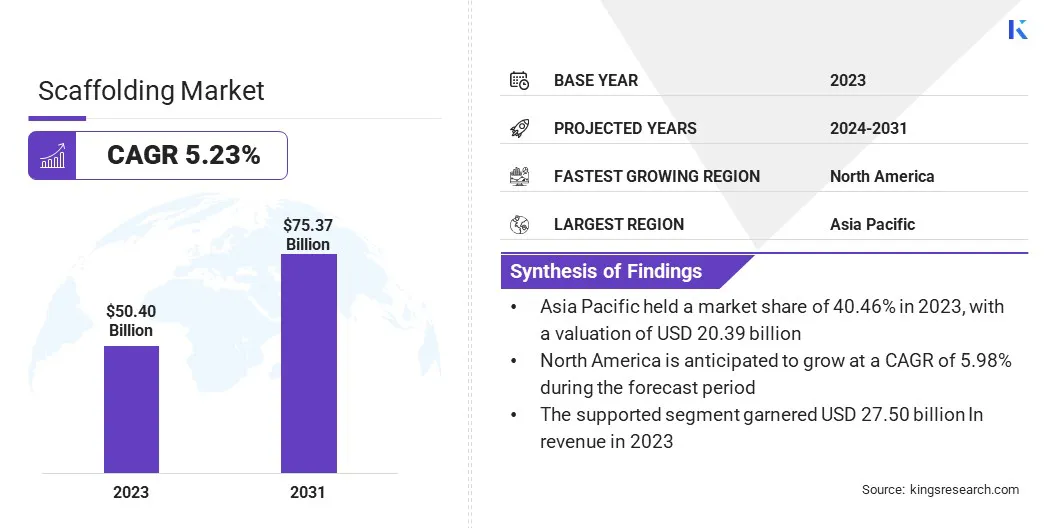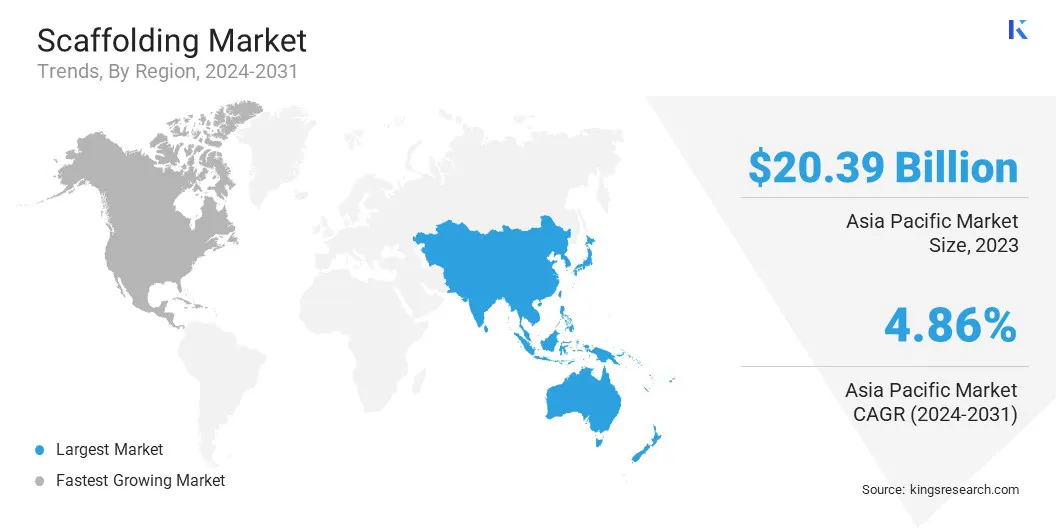Scaffolding Market Size
The Global Scaffolding Market size was valued at USD 50.40 billion in 2023 and is projected to reach USD 75.37 billion by 2031, growing at a CAGR of 5.23% from 2024 to 2031. In the scope of work, the report includes products offered by companies such as ADTO Inc., Cangzhou Weisitai Scaffolding Co.,Ltd, Entrepose Echafaudages, Fast & Fasten Scaffold, Layher North America, Rapid Scaffolding(Engineering) Co., Ltd., WM-Scaffold, Youying Construction Scaffold, ALTRAD , MJ-GERÜST and Others.
The growth of the scaffolding market is driven by the ongoing expansion of the construction industry, particularly in emerging economies. Furthermore, stringent safety regulations that mandate the use of scaffolds in construction projects bolster market growth. Advancements in scaffold materials and design, along with a major focus on durability and ease of assembly, are attracting contractors and builders.
Additionally, the increasing adoption of modular scaffolding systems enhances efficiency and safety on construction sites, thereby boosting market progress.
The scaffold market presents a dynamic landscape, characterized by robust growth opportunities attributable to the steady expansion of the construction industry worldwide. This is leading to an increased demand for scaffolding solutions.
Moreover, key market players are constantly innovating and investing in research and development to offer advanced scaffold systems that ensure optimal safety and efficiency on construction sites. The market is further influenced by evolving regulatory frameworks, with a particular emphasis on workplace safety, prompting industry participants to invest in technologically advanced scaffolding solutions.
Scaffolds are essential components in various industries such as residential, commercial, industrial, and infrastructure development. They are designed to withstand varying loads and environmental conditions, thereby ensuring stability and reliability throughout construction projects.
The scaffold market encompasses a diverse range of temporary structures used in construction, renovation, and maintenance activities. These structures provide both support and access to workers and materials at elevated heights, thus enhancing operational efficiency and safety standards at construction sites. The market encompasses traditional tube and clamp scaffolds, frame scaffolds, and innovative modular systems, catering to diverse customer needs and industry requirements.

Analyst’s Review
Manufacturers in the scaffold market are focusing on developing innovative scaffold designs for enhanced safety and efficiency. Development of new materials, such as lightweight and durable scaffolds, is gaining traction with additional investments in the development of eco-friendly materials to align with sustainability goals. Players in the industry are collaborating with construction firms to develop customized solutions, thereby enhancing market competitiveness while addressing evolving industry demands.
Scaffolding Market Growth Factors
The continuous innovation in scaffold materials and designs drives the growth of the market. Companies are investing heavily in research and development to improve the durability, flexibility, and safety features of scaffolding systems. Advanced materials, such as lightweight alloys and high-strength composites, are being integrated into scaffold components to improve load-bearing capacities and reduce assembly times.
Innovative designs, including modular and pre-fabricated systems, offer increased versatility and efficiency at construction sites. These ongoing advancements attract customers who seek reliable and cost-effective scaffold solutions, thereby stimulating market growth and fostering competitiveness.
Ensuring compliance with evolving safety regulations poses a significant challenge to market development. Construction companies are facing increasing pressure to adhere to strict safety standards, leading to complexities in scaffold design and usage. To overcome this challenge, industry stakeholders are prioritizing comprehensive training programs for workers on scaffold safety protocols and procedures.
Additionally, leveraging technology, such as virtual reality simulations and IoT-enabled monitoring systems, is facilitating the enhancement of safety awareness and enabling real-time risk mitigation. Collaborative efforts between regulators, industry players, and educational institutions are crucial in addressing safety challenges and promoting a culture of safety within the scaffolding market.
Scaffolding Market Trends
The increasing adoption of sustainable scaffold materials and practices prompts companies to incorporate eco-friendly alternatives such as bamboo scaffolds, recyclable metals, and bio-based composites, thereby reducing environmental impact. Sustainable scaffold designs focus on minimizing waste, optimizing resource use, and promoting reusability.
Moreover, a growing emphasis on green construction practices is leading to a surge in demand for scaffolding solutions that align with sustainability goals. This reflects a shift in customer preferences toward environmentally conscious products and services, thereby influencing market dynamics and fostering innovation in sustainable scaffold technologies.
The integration of digital technologies in scaffold design and management significantly impacts the industry, prompting prominent players to leverage Building Information Modeling (BIM), drones, and IoT sensors to enhance planning, monitoring, and maintenance of scaffolding systems.
BIM enables virtual modeling of scaffolds, which facilitates accurate design, simulation, and collaboration among stakeholders. Drones are used for aerial inspections, while IoT sensors provide real-time data on scaffold performance and safety. This digital transformation optimizes workflow efficiency, reduces costs, and improves safety outcomes in scaffold operations, thereby propelling the market toward smart and interconnected scaffold solutions.
Segmentation Analysis
The global scaffolding market is segmented based on type, material type, end-use industry, and geography.
By Type
Based on type, the market is categorized into supported, suspended, and rolling. The supported segment led the market in 2023, reaching a valuation of USD 27.50 billion. This dominance is fueled by its versatility and widespread applicability across various construction projects. Supported scaffolds offer robust support and stability, catering to the diverse needs of construction sites, ranging from residential buildings to large-scale infrastructure projects. Their ease of assembly and adaptability to different terrains make them preferred choices for contractors and builders.
Additionally, stringent safety regulations mandate the use of supported scaffolds in many jurisdictions, thereby amplifying demand. These factors are collectively contributing to the expansion of the supported segment, consolidating its position in the global market.
By Material Type
Based on material type, the market is segmented into aluminum, steel, and wood. The aluminum segment is poised to witness significant growth at a CAGR of 6.07% through the forecast period. This growth can be attributed to several factors such as lightweight construction, corrosion resistance, and ease of transportation & assembly. These qualities make aluminum scaffolds ideal for applications requiring both mobility and durability, including maintenance and repair work in various industries.
Furthermore, increasing investments in infrastructure development projects globally are contributing to the rising demand for lightweight and high-strength scaffold materials such as aluminum. The aluminum segment is expected to witness significant expansion in the forthcoming years, fueled by growing adoption and technological advancements in aluminum scaffold designs.
By End-Use Industry
Based on end-use industry, the market is divided into construction, oil & gas, ship building, and others. The construction industry segment secured the largest revenue share of 56.67% in 2023. This segmental growth is driven by the sector's inherent demand for scaffold solutions across diverse project types and scales.
Scaffolds play a crucial role in providing access, support, and safety for workers during construction activities, ranging from building construction to infrastructure development projects. As construction activities continue to rise globally, propelled by infrastructure development initiatives and rapid urbanization, the demand for scaffolds in the construction sector is expected to remain robust.
Scaffolding Market Regional Analysis
Based on region, the global scaffolding market is classified into North America, Europe, Asia-Pacific, MEA, and Latin America.

The Asia Pacific Scaffolding Market share stood around 40.46% in 2023 in the global market, with a valuation of USD 20.39 billion due to the region's robust construction industry, driven by rapid urbanization, infrastructure development initiatives, and growing investments in residential and commercial projects.
Additionally, favorable government policies promoting construction activities and safety standards support regional market growth. Moreover, the presence of key market players, technological advancements in scaffold materials and designs, and increasing adoption of modular scaffold systems bolster the region's dominance in the scaffold market.
North America is likely to experience significant growth at a 5.98% CAGR between 2024 and 2031, largely attributed to increased investments in construction and renovation projects across residential, commercial, and industrial sectors. Moreover, stringent safety regulations and standards in North America boost demand for scaffolding in the region.
Additionally, ongoing advancements in scaffold materials, such as aluminum and high-strength composites, cater to the region's growing preference for durable and efficient scaffold solutions. These factors, coupled with technological innovations and infrastructure developments, position North America for significant growth in the scaffold market.
Competitive Landscape
The global scaffolding market study will provide valuable insight with an emphasis on the fragmented nature of the industry. Prominent players are focusing on several key business strategies such as partnerships, mergers and acquisitions, product innovations, and joint ventures to expand their product portfolio and increase their market shares across different regions. Manufacturers are adopting a range of strategic initiatives, including investments in R&D activities, the establishment of new manufacturing facilities, and supply chain optimization, to strengthen their market standing.
List of Key Companies in Scaffolding Market
- ADTO Inc.
- Cangzhou Weisitai Scaffolding Co.,Ltd
- Entrepose Echafaudages
- Fast & Fasten Scaffold
- Layher North America
- Rapid Scaffolding(Engineering) Co., Ltd.
- WM-Scaffold
- Youying Construction Scaffold
- ALTRAD
- MJ-GERÜST
Key Industry Developments
- March 2024 (Launch): PERI introduced its cladding system to the UK scaffolding market. The PERI UP Cladding system worked with the company’s system scaffolding products to create a flexible enclosure. It used lightweight components, providing considerable advantages over currently existing systems. The system included large translucent panels with integrated handrails, eliminating the need for specialized tools. Its efficiency in enclosing construction sites with fewer components ensured quick and adaptable installations.
- November 2023 (Expansion): Layher inaugurated its latest production facility, "Plant 3," with a major focus on manufacturing Allround Scaffolding. The plant covered approximately 27 acres, and was highly automated and energy-efficient, ensuring top-notch product quality and timely delivery for customers. It incorporated advanced production and storage methods, digitalization initiatives, and energy-saving technologies, including building insulation, a photovoltaic system, and heat recovery systems in line with high energy efficiency standards.
The Global Scaffolding Market is Segmented as:
By Type
- Supported
- Suspended
- Rolling
By Material Type
By End-Use Industry
- Construction
- Oil & Gas
- Ship Building
- Others
By Region
- North America
- Europe
- France
- U.K.
- Spain
- Germany
- Italy
- Russia
- Rest of Europe
- Asia-Pacific
- China
- Japan
- India
- South Korea
- Rest of Asia-Pacific
- Middle East & Africa
- GCC
- North Africa
- South Africa
- Rest of Middle East & Africa
- Latin America
- Brazil
- Argentina
- Rest of Latin America


